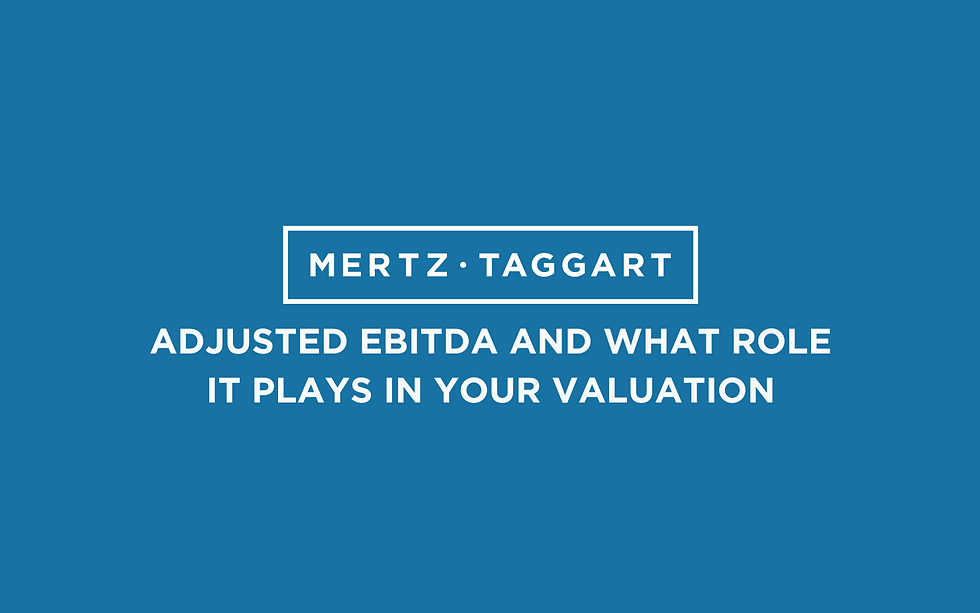What is Adjusted EBITDA and What Role Does it Play in Your Home Health or Hospice Valuation?
- Admin
- Jun 3, 2022
- 3 min read
Updated: Dec 10, 2024

Adjusted EBITDA is an estimate of the normalized pre-tax cash flow to all providers of capital (debt and equity) for the business. ‘Normalized’ means it is the expected cash flow under normal conditions in the immediate future – it excludes one-time, extraordinary events.
Let’s begin by defining EBITDA, which is an acronym for Earnings Before Interest Taxes Depreciation and Amortization.
E: Earnings = Revenue minus Cost of Sales minus G&A (General & Administrative) expenses. In other words, net income.
B: Before = Illustrates the requirement to exclude or back out certain expenses included in the earnings definition above.
I: Interest = Interest paid on debt and interest received. Since the calculation of earnings above includes interest, we will add back interest expenses and subtract interest income.
T: Taxes = State and federal income taxes. We will add back state and federal income taxes because another owner may have different tax implications.
D: Depreciation = Depreciation expense. This is a non-cash expense.
A: Amortization = Amortization expense. Another non-cash expense.
Next, we will make the appropriate adjustments to arrive at Adjusted EBITDA. We can group adjustments into four categories:
One-time extraordinary income or expenses
Business expenses that will not reoccur in the future
Non-business-related expenses
Personal expenses run through the business that a buyer will no longer incur
One-time extraordinary income or expenses include:
Gain/loss on sale or disposal of an asset. If it is a gain, then you would subtract it from EBITDA. If it is a loss, then you would add it to EBITDA.
Restructuring expenses such as moving expenses, severance packages, etc.
Legal expenses – due to a lawsuit
Consulting expenses for a specific project
Accounting expenses for an audit
Non-business-related expenses include:
Owner’s compensation relative to fair market. Suppose the owner is the administrator, and has a salary of $225k. Assume the salary market rate for an administrator of an agency with similar characteristics is $100k. The adjustment would add the difference between these two amounts ($125k) to EBITDA.
Non-market rent expense. Suppose the agency owner owns the building and leases the office to the business. If the rent charged to the agency is greater than the market rate, then you will add the difference to EBITDA. If it is lower, you will subtract it from EBITDA.
Personal expenses include:
Owner’s non-business meals and entertainment
Owner’s personal auto expenses
Owner’s cell phone bill
Owner’s non-business travel expenses
Family members who are paid by the agency, but who are not necessary for operations
Once we have completed the list of adjustments, we add or subtract each to EBITDA to arrive at Adjusted EBITDA.
Why is Adjusted EBITDA important, and what is its role in your hospice or home health valuation?
It provides a future cash flow estimate for potential acquirers to build their valuation models, specifically discounted cash flow models (DCF).
It is the industry standard for valuing home health and hospice agencies, and provides a method for buyers to project their expected cash flow of the agency and the ability to pay for the acquisition.
Finally, “the multiple” often quoted in home health and hospice M&A deal announcements is a risk-adjusted number that is applied to the Adjusted EBITDA to determine Total Enterprise Value, or purchase price.
For a confidential valuation of your home health or hospice, please email us at info@mertztaggart.com

The VAT Calculator on vatcalc.onl is a great option for those looking for a hassle-free VAT solution. It works quickly, is free, and always has the most up-to-date UK VAT rates.